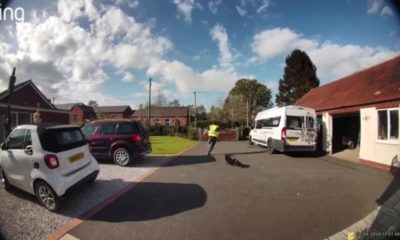Minor strokes should be treated as a medical emergency: study
The advice published in the journal Stroke is aimed specifically at hospitals in rural areas that may not have access to advanced imaging or an on-site neurologist.
Published
1 year ago onBy
Talker News
By Mark Waghorn via SWNS
Minor strokes should be treated as a medical emergency - like a heart attack, according to a new study.
Symptoms usually disappear after a few minutes - leading to them being wrongly regarded as a "gentle warning."
But scientists say that nearly one in five patients will go on to have a full-blown stroke within three months - around half in the next couple of days.
The American Heart Association said they need an immediate assessment and new statement offers specific guidance for health care professionals.
Two-fifths, given the appropriate scan, will learn they have actually had a stroke instead of a transient ischaemic attack (TIA) or mini-stroke.
Comprehensive scans may help determine high-risk individuals who should be hospitalized.
Writing committee chair professor Hardik Amin, of Yale New Haven Hospital said: "Confidently diagnosing a TIA is difficult since most patients are back to normal function by the time they arrive at the emergency room.
"There also is variability across the country in the workup that TIA patients may receive.
"This may be due to geographic factors, limited resources at health care centres or varying levels of comfort and experience among medical professionals."
The advice published in the journal Stroke is aimed specifically at hospitals in rural areas that may not have access to advanced imaging or an on-site neurologist.
A TIA is a temporary blockage of blood flow to the brain. At least 240,000 people are affected in the US each year. The number is probably higher due to under-reporting.
It doesn't cause permanent damage - but roughly ten percent will have a full-blown attack within two days.
A TIA is more accurately described as a warning stroke rather than a 'mini-stroke' as it's often called.
Symptoms are the same as stroke - only temporary. They begin suddenly and may have any or all of these characteristics:
- Symptoms begin strong then fade
- Symptoms typically last less than an hour
- Facial droop
- Weakness on one side of the body
- Numbness on one side of the body
- Trouble finding the right words/slurred speech
- Dizziness, vision loss or trouble walking.
The F.A.S.T. acronym for stroke symptoms can be used to identify a TIA: F ― Face drooping or numbness; A ― Arm weakness; S ― Speech difficulty; T ― Time to call 9-1-1, even if the symptoms go away.
Amin said: "Someone with a TIA who goes to an emergency room with limited resources may not get the same evaluation that they would at a certified stroke centre.
"This statement was written with those emergency room physicians or internists in mind – professionals in resource-limited areas who may not have immediate access to a vascular neurologist and must make challenging evaluation and treatment decisions."
The statement also includes guidance to help health care professionals tell the difference between a TIA and a 'TIA mimic'.
The condition shares similarities with TIA but can be due to low blood sugar, a seizure or a migraine. Symptoms tend to spread to other parts of the body and build in intensity over time.
People with cardiovascular risk factors, such as high blood pressure, diabetes, obesity, high cholesterol and smoking, are at high risk for stroke and TIA.
Other conditions that increase risk of a TIA include peripheral artery disease, atrial fibrillation, obstructive sleep apnea and coronary artery disease.
In addition, a person who has had a prior stroke is at high risk for TIA.
After assessing for symptoms and medical history, imaging of the blood vessels in the head and neck is an important first assessment.

A CT head scan should be done initially in the emergency department to rule out intracerebral hemorrhage or a TIA.
CT angiography may be done as well to look for signs of narrowing in the arteries leading to the brain.
Nearly half of people with TIA symptoms have narrowing of the large arteries that lead to the brain.
An MRI (magnetic resonance imaging) scan is the preferred way to rule out a stroke, ideally done within 24 hours of when symptoms began.
About 40% of patients presenting in the ER with TIA symptoms will actually be diagnosed with a stroke based on MRI results.
Some emergency rooms may not have access to an MRI scanner, and they may admit the patient to the hospital for MRI or transfer them to a center with rapid access to one.
Blood work should be completed in the emergency department to rule out other conditions that may cause TIA-like symptoms, such as low blood sugar or infection, and to check for cardiovascular risk factors like diabetes and high cholesterol.
Once TIA is diagnosed, a cardiac work-up is advised due to the potential for heart-related factors to cause a TIA. Ideally, this assessment is done in the emergency department.
It could be coordinated as a follow-up visit with the appropriate specialist, preferably within a week of having a TIA.
An electrocardiogram to assess heart rhythm is suggested to screen for atrial fibrillation, which is detected in up to 7% of people with a stroke or TIA.
Amin said: "Incorporating these steps for people with suspected TIA may help identify which patients would benefit from hospital admission, versus those who might be safely discharged from the emergency room with close follow-up.
"This guidance empowers physicians at both rural and urban academic settings with information to help reduce the risk of future stroke."
Stroke affects about 100,000 Britons annually. There are 1.3 million survivors in the UK.
Stories and infographics by ‘Talker Research’ are available to download & ready to use. Stories and videos by ‘Talker News’ are managed by SWNS. To license content for editorial or commercial use and to see the full scope of SWNS content, please email [email protected] or submit an inquiry via our contact form.
You may like


Metals can heal themselves just like ‘The Terminator’


Two-faced star has hydrogen on one side and helium on other


World’s oldest big game hunting weapon found


An espresso a day could keep Alzheimer’s at bay


Being bipolar significantly raises risk of premature death: study


Soccer players who regularly use head more likely to develop Alzheimer’s
Other Stories


Pro mermaid’s career goes swimmingly after overcoming ocean fear
She makes up to $8,000 a show.


Giant prehistoric salmon used tusk-like teeth to fight off predators
The species that grew up to nine feet long lived in the North American Pacific Northwest.


Evidence of Earth’s magnetic field dates back 3.7 billion years
Life on Earth would not be possible without its magnetic field.


Adorable video shows baby rhino enjoying sunshine
By Faye Mayern via SWNS An endangered baby rhino has well and truly found its feet after being filmed playing...


Hilarious moment delivery man gets chased by tiny dog
The hilarious encounter was caught on video.
Top Talkers

 Parenting7 days ago
Parenting7 days agoSingle mom details struggles of feeding her 12 kids

 Lifestyle5 days ago
Lifestyle5 days agoWoman regrets her tattoo nightmare: ‘It’s horrendous’

 Good News2 days ago
Good News2 days agoDisabled student takes first steps in 10 years on graduation stage

 Broadcast1 week ago
Broadcast1 week agoOver 40% of Americans have no clue what a 401k is

 Broadcast1 week ago
Broadcast1 week agoHow hard is it for Americans to live sustainably?

 Health2 days ago
Health2 days agoNew study reveals ‘old age’ begins later than it used to

 Money1 week ago
Money1 week agoOver 40% of Americans have no clue what a 401k is

 Wildlife1 day ago
Wildlife1 day agoClever elephant returns visitor’s shoe after falling into enclosure
